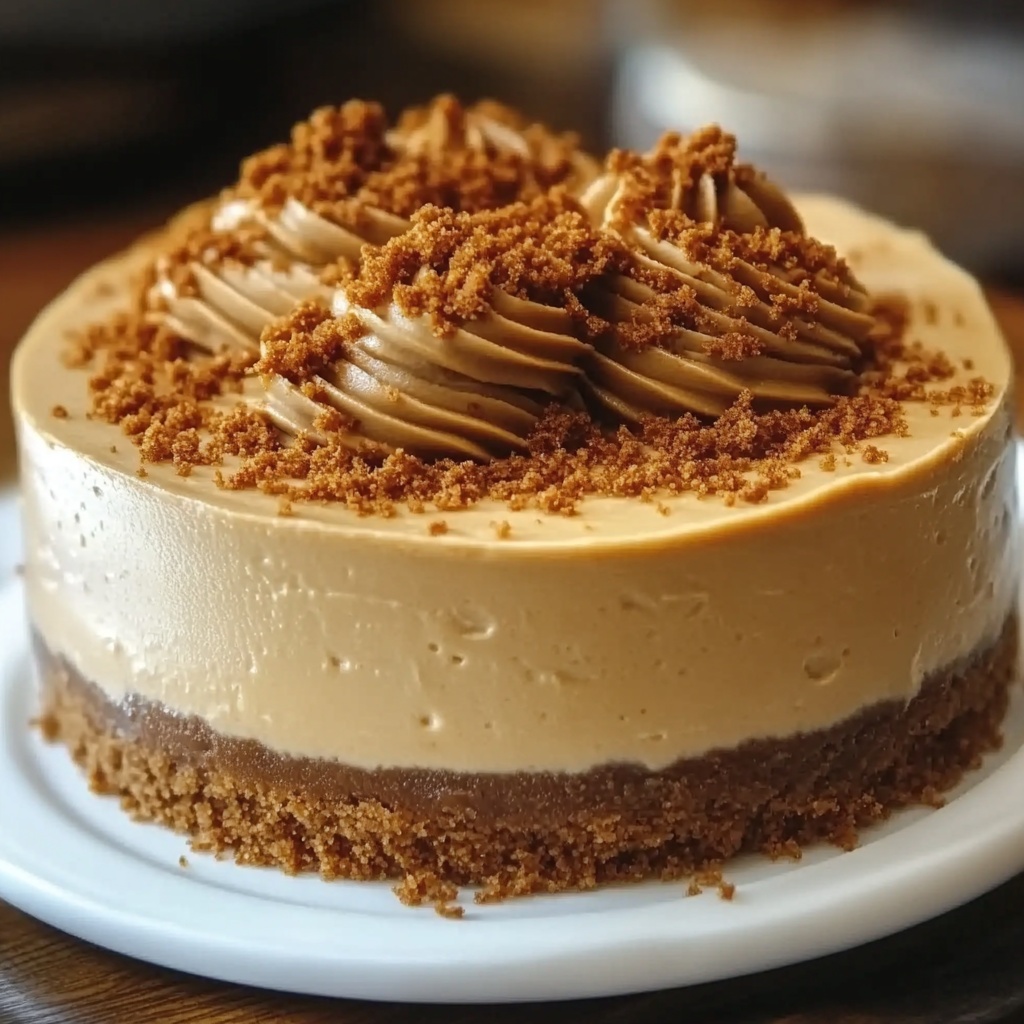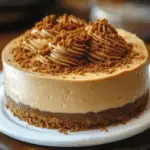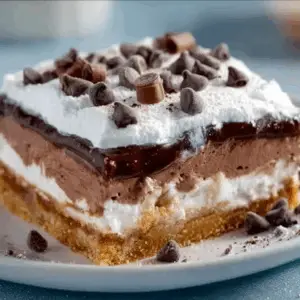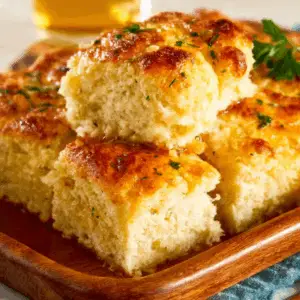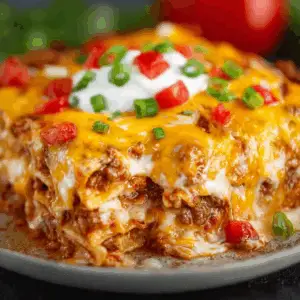If you’ve been searching for a dessert that’s unexpectedly decadent, visually appealing, and easy to prepare, then the Biscoff cheesecake is the indulgence you didn’t know you needed. The unique combination of spiced Biscoff cookies and rich, creamy cheesecake creates a dessert that stands out from the typical lineup of sweets, offering an ideal balance of caramelized flavor and silky texture.
As social media continues to fuel culinary trends, Biscoff desserts—from lattes to layered bars—have surged in popularity. Among these, the cheesecake variant is stealing the spotlight. With visually stunning swirls of cookie butter and golden cookie crumbs, it’s easy to see why the Biscoff cheesecake is dominating Pinterest boards and recipe blogs alike. Pinterest’s search results are filled with beautiful presentation ideas that inspire home bakers worldwide.
What makes it so compelling is not just the flavor—it’s the versatility. Whether served at a cozy family dinner or featured on a dessert buffet, this cheesecake adapts beautifully. For a bit of historical context, consider how cheesecake has evolved over centuries. From the baked custards of Ancient Greece to modern adaptations like Biscoff cheesecake, the dessert has embraced ingredients from across cultures. You can trace this journey through the Wikipedia entry on the history of cheesecake, which reveals how this dessert has consistently evolved while staying rooted in rich, creamy indulgence.
This guide explores every aspect of making and serving Biscoff cheesecake, including detailed steps, ingredient breakdowns, storage solutions, and creative variations. Whether you’re a seasoned baker or a curious newbie, this is your ultimate blueprint for mastering the dessert that’s as satisfying to eat as it is to share on social media.
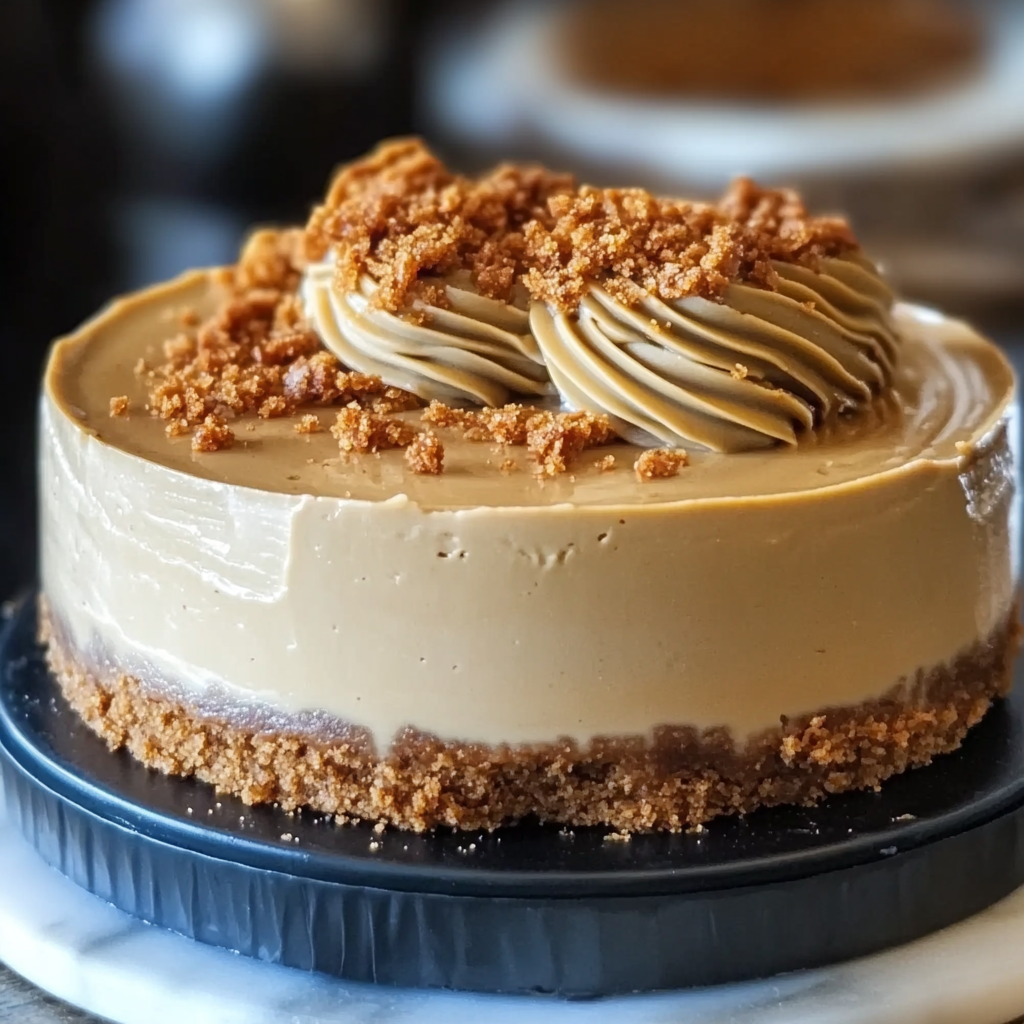
What is Biscoff? The Secret Ingredient Behind the Magic
At the heart of Biscoff cheesecake is the ingredient that gives this dessert its irresistible charm: Biscoff cookies and their creamy cousin, Biscoff cookie butter. Originally known as speculoos, these spiced caramelized biscuits were first crafted in Belgium and have been enjoyed across Europe for decades. The most recognized version is produced by Lotus Bakeries, which helped popularize Biscoff as a global brand.
These crunchy cookies, made with brown sugar and a signature blend of warm spices, offer a deep, toasty flavor that contrasts beautifully with smooth ingredients like cream cheese. The result is a dessert with layers of texture and depth, bringing a rich, slightly spiced profile to every bite. Thanks to the growing popularity of European flavors, Biscoff has become a staple in American kitchens, especially for bakers seeking a twist on the traditional graham cracker crust.
The true game-changer, however, is cookie butter—a spreadable paste made from crushed Biscoff cookies, sugar, and oils. This silky concoction has a nutty texture and buttery finish, reminiscent of peanut butter but without the nuts. According to the Wikipedia entry on cookie butter, it’s become an essential pantry item for dessert lovers, ideal for spreading, baking, or layering in no-bake treats.
Biscoff’s surge in popularity has also been influenced by viral trends on platforms like Pinterest, where bakers and food bloggers showcase endless variations—from mini cheesecake jars to Biscoff-stuffed brownies. These visually appealing creations tap into the ongoing fascination with photogenic desserts that taste as good as they look.
So why does Biscoff work so well in cheesecake? The spiced caramel notes of the cookies perfectly complement the tanginess of cream cheese, creating a flavor harmony that feels both nostalgic and new. This marriage of textures and flavors is what makes Biscoff cheesecake stand out from the crowd
A Short History of Cheesecake and its Modern Variations
While Biscoff cheesecake may feel like a new trend, it’s actually the latest evolution in a dessert that dates back over 4,000 years. The earliest versions of cheesecake were enjoyed in Ancient Greece, where athletes were even served a simple version made with cheese and honey during the first Olympic games. Later, the Romans adapted it, and by the time it reached Europe, it began to resemble the sweet, creamy dessert we know today. The full historical journey of this iconic dessert is detailed in Wikipedia’s article on cheesecake, offering insight into how cultural shifts have shaped its ingredients and forms.
The most famous variation is the New York-style cheesecake, introduced in the early 20th century. Known for its dense texture and rich flavor, it set the standard for what a cheesecake should be in the U.S. However, bakers soon began experimenting with crusts, fillings, and toppings. From Oreo and strawberry swirls to peanut butter and matcha infusions, the cheesecake became a canvas for creativity. As tastes evolved and dietary trends shifted, the dessert adapted further, giving rise to no-bake versions, vegan alternatives, and, more recently, flavor fusions like Biscoff.
What sets Biscoff apart in this evolution is its ability to offer both crunch and creaminess—delivered through a buttery crust made from crushed Biscoff cookies and a silky topping of melted cookie butter. These innovations, often showcased on platforms like Pinterest, allow both home bakers and professionals to present cheesecakes in everything from jars to bars and even elaborate dessert boards. The popularity of these visual formats underscores how important presentation has become in the age of social media and food blogging.
Today, cheesecake is no longer confined to a single style or flavor. With the rise of global ingredients and digital food culture, modern variations like Biscoff cheesecake embody a new era of dessert-making—one that’s adventurous, photogenic, and irresistibly delicious.
Ingredients Breakdown: What Makes This Cheesecake Irresistible
The success of a perfect Biscoff cheesecake lies in its carefully chosen ingredients, each contributing to its rich texture and signature flavor. Here’s a closer look at what makes this dessert unforgettable:
-
Crust
-
2 cups Biscoff cookie crumbs: These cookies form the base of the cheesecake, replacing traditional graham crackers with a spiced, caramel flavor.
-
5 tablespoons melted unsalted butter: This binds the crumbs and ensures a firm, buttery base that complements the creamy filling.
-
-
Filling
-
24 oz (675g) cream cheese, softened: The foundation of the cheesecake, creating a rich and tangy texture. Cream cheese is essential for achieving that smooth, dense consistency.
-
1 cup granulated sugar: Adds sweetness and helps to balance the slight tang of the cream cheese.
-
1 cup Biscoff cookie butter: This luxurious ingredient infuses the entire filling with warm, caramelized spice notes. For more on this spread, refer to cookie butter.
-
1 tsp vanilla extract: Enhances the overall flavor and ties the ingredients together.
-
3 large eggs: These provide structure and stability as the cheesecake bakes.
-
½ cup sour cream: Contributes a silky texture and slight acidity that deepens the flavor profile.
-
-
Topping
-
½ cup melted Biscoff cookie butter: Drizzled over the cooled cheesecake for a glossy, indulgent finish.
-
Crushed Biscoff cookies: Sprinkled for garnish and added crunch.
-
Each ingredient works in harmony to create a cheesecake that’s creamy, spiced, and deeply satisfying. For creative twists, many bakers explore variations like vegan Biscoff cheesecake ideas or mini versions served in jars.
Step-by-Step Guide to Making Biscoff Cheesecake
Making Biscoff cheesecake is simpler than it looks. Follow these steps to ensure a foolproof, bakery-style dessert:
1. Prepare the Crust
-
Preheat oven to 325°F (165°C).
-
Combine Biscoff cookie crumbs with melted butter until evenly moistened.
-
Press into a 9-inch springform pan. Use the back of a spoon or flat-bottom glass for an even layer.
-
Bake for 10 minutes, then set aside to cool.
2. Make the Filling
-
Beat softened cream cheese until smooth and fluffy.
-
Gradually mix in granulated sugar.
-
Add Biscoff cookie butter and vanilla extract. Blend until well combined.
-
Beat in eggs, one at a time, just until incorporated—overmixing can introduce air and cause cracks.
-
Mix in sour cream last, stirring gently to keep the texture creamy.
3. Bake the Cheesecake
-
Pour the filling over the cooled crust and smooth the top.
-
Place pan in a water bath (wrap bottom in foil to prevent leaks) to prevent cracking and ensure even baking.
-
Bake for 55–65 minutes or until edges are set and center is slightly jiggly.
-
Turn off the oven, crack the door, and let cheesecake cool inside for 1 hour.
4. Chill and Decorate
-
Refrigerate for at least 4 hours or overnight.
-
Before serving, melt cookie butter and pour over top.
-
Garnish with crushed Biscoff cookies or explore ideas like edible flowers from Pinterest dessert boards.
For more on cheesecake baking techniques, refer to Wikipedia’s baking article for foundational practices.

Why Biscoff Cheesecake is Perfect for Any Occasion
From casual brunches to holiday feasts, Biscoff cheesecake fits effortlessly into any gathering:
-
Visually stunning: Its warm caramel hue and crumbly topping make it a standout on any dessert table.
-
Universally loved: The spiced cookie flavor appeals to adults and kids alike.
-
Customizable: Easily adapted into bars, jars, or mini cheesecakes for different settings.
-
Transportable: Holds its structure well, making it ideal for potlucks or parties.
Whether you’re hosting or gifting, Biscoff cheesecake adds a polished, gourmet touch that’s easier to make than it looks.
Delicious Variations of Biscoff Cheesecake
If you love the classic version, consider these creative spins:
-
No-bake Biscoff cheesecake: Ideal for summer days when you don’t want to heat the oven. Try no-bake jar versions for individual servings.
-
Mini cheesecakes: Bake in muffin tins or glass jars—perfect for parties or gifts. Explore mini Biscoff desserts.
-
Vegan/dairy-free: Use plant-based cream cheese and coconut cream. Get inspiration from Pinterest’s vegan Biscoff cheesecake ideas.
-
Cheesecake bars: Easier to slice and serve, ideal for picnics and large groups.
These options maintain the signature Biscoff flavor while offering flexibility in format and dietary preferences.
Serving Suggestions & Presentation Tips
Elevate your Biscoff cheesecake with these styling tips:
-
Use a sharp, hot knife for clean slices. Wipe between cuts.
-
Drizzle extra cookie butter or caramel over each slice.
-
Pair with espresso or spiced chai for complementary flavors.
-
Add whipped cream, gold flakes, or berries for a pop of color.
Browse cheesecake presentation ideas for stunning ways to plate your dessert like a pro.
How to Store and Freeze Biscoff Cheesecake
Keep your Biscoff cheesecake fresh with these storage methods:
-
Refrigeration: Store tightly covered in the fridge for up to 5 days.
-
Freezing: Freeze whole or in slices. Wrap in plastic and foil for best results. Lasts up to 2 months.
-
Thawing: Defrost in the refrigerator overnight. Avoid microwaving to preserve texture.
-
Make-ahead tip: Prepare 2 days before serving for enhanced flavor and ease.
This makes it a perfect make-ahead dessert, especially during the holidays.
Common Mistakes to Avoid When Making Biscoff Cheesecake
Even simple recipes have pitfalls. Avoid these:
-
Overmixing: Introduces air, leading to cracks.
-
Skipping water bath: Causes uneven baking and dry edges.
-
Opening oven too early: Sudden temperature drops can deflate the cake.
-
Not cooling properly: Cheesecake needs a slow cool to set properly.
-
Using cold ingredients: Leads to lumpy batter.
For more cheesecake baking do’s and don’ts, refer to baking fundamentals to avoid common mishaps.

FAQs
What does Biscoff cheesecake taste like?
It has a rich, creamy base with caramelized spice flavors from the Biscoff cookies and cookie butter. The result is a warm, buttery sweetness with a hint of cinnamon and ginger.
Is Biscoff cheesecake too sweet?
Not necessarily. The tanginess from cream cheese and sour cream balances the sweetness. Adjust the sugar slightly if you prefer a less sweet version.
Can I make Biscoff cheesecake without baking?
Yes! Use the same crust and filling but skip the eggs. Chill for at least 6 hours to set. See Pinterest no-bake jars for inspiration.
Can I use generic cookie butter instead of Lotus Biscoff?
Absolutely. Most cookie butter brands offer a similar taste, though Lotus tends to be slightly richer in spice.
How do I keep cheesecake from cracking?
Use a water bath, don’t overmix, and let it cool gradually. Follow the detailed steps above for a crack-free finish.
Can I make this dessert gluten-free or vegan?
Yes. Use gluten-free cookies and dairy-free alternatives. Check vegan recipe variations for ideas.
What toppings go well with Biscoff cheesecake?
Whipped cream, caramel sauce, crushed cookies, or even a dash of sea salt pair beautifully. For ideas, browse dessert board inspiration.
PrintWhy Biscoff Cheesecake is the Dessert You Didn’t Know You Needed
This Biscoff cheesecake recipe combines crushed Biscoff cookies, creamy cheesecake filling, and a decadent cookie butter topping to create a dessert that’s both rich and sophisticated. With a spiced, buttery flavor and smooth texture, it’s perfect for impressing guests or satisfying your sweet tooth at home.
- Author: Clara
Ingredients
For the crust:
- 2 cups Biscoff cookie crumbs
- 5 tbsp unsalted butter, melted
For the filling:
- 24 oz (675g) cream cheese, softened
- 1 cup granulated sugar
- 1 cup Biscoff cookie butter
- 1 tsp vanilla extract
- 3 large eggs
- ½ cup sour cream
For the topping:
- ½ cup Biscoff cookie butter, melted
- Crushed Biscoff cookies for garnish
Instructions
Preheat your oven to 325°F (165°C).
Mix the Biscoff cookie crumbs and melted butter in a bowl until well combined. Press the mixture firmly into the bottom of a 9-inch springform pan. Set aside.
In a large bowl, beat the cream cheese until smooth. Add sugar and mix until fully incorporated.
Add the cookie butter and vanilla extract, mixing until creamy.
Add the eggs one at a time, mixing just until blended.
Mix in the sour cream until the filling is smooth and uniform.
Pour the cheesecake filling over the prepared crust. Smooth the top with a spatula.
Bake for 55-65 minutes or until the center is almost set.
Turn off the oven, crack the door open, and let the cheesecake cool inside for 1 hour.
Remove and refrigerate for at least 4 hours or overnight.
Before serving, melt the cookie butter and pour it over the chilled cheesecake. Garnish with crushed Biscoff cookies.
Notes
-
For best results, allow all ingredients to come to room temperature before mixing.
-
Use a water bath for even baking and a smooth surface.
-
Chill overnight for the ideal texture and flavor.
-
Customize with fruit, caramel, or chocolate drizzle for a creative twist.
-
This recipe yields 10–12 slices and keeps well in the refrigerator for several days.
